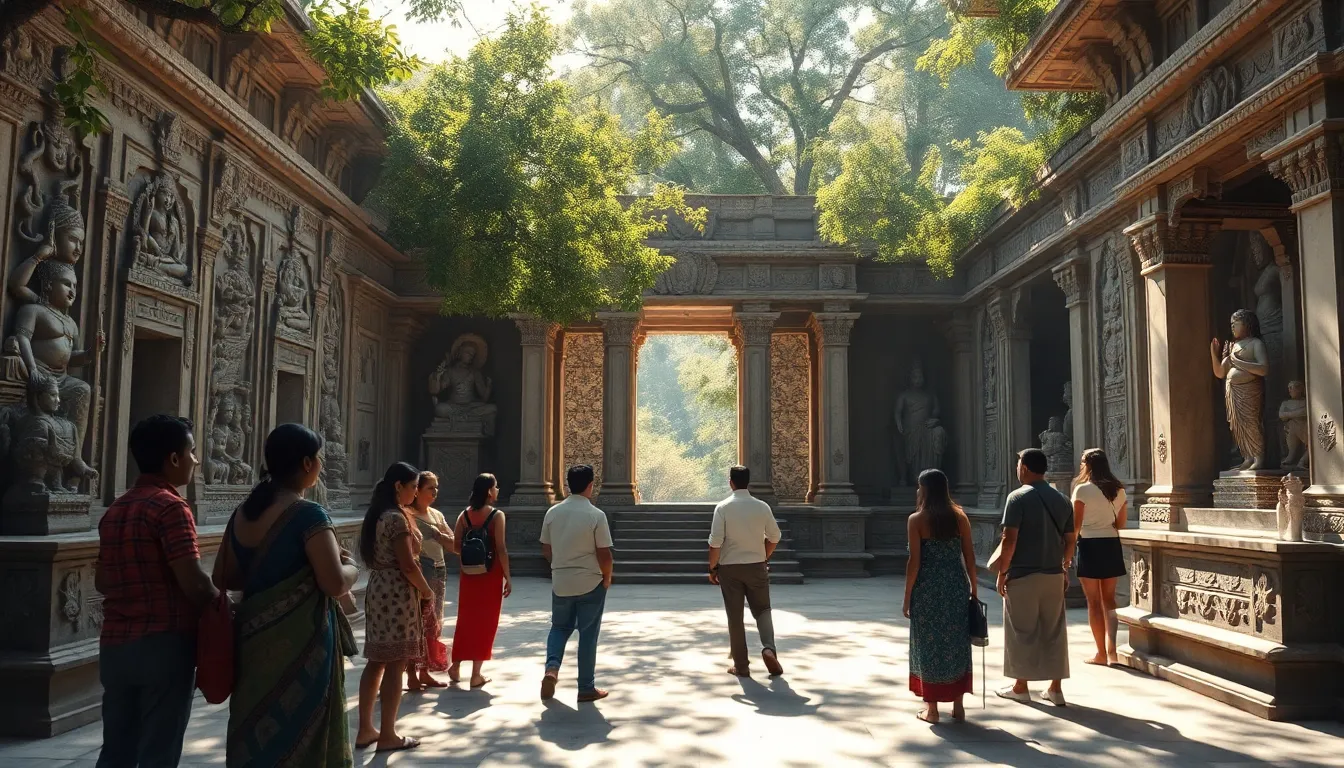Table of Contents
ToggleNishidhasagamam, a fascinating concept rooted in ancient Indian philosophy, delves into the intricacies of forbidden actions and their implications on personal and societal ethics. This term, often explored within the context of Dharma, highlights the importance of understanding moral boundaries and the consequences of transgressing them.
As society evolves, the relevance of nishidhasagamam becomes increasingly significant, prompting discussions on ethics, morality, and cultural practices. By examining this concept, one uncovers the rich tapestry of beliefs that shape human behavior and decision-making. Understanding nishidhasagamam not only enriches one’s knowledge of philosophical traditions but also offers valuable insights into contemporary moral dilemmas.
Overview of Nishidhasagamam
Nishidhasagamam represents a fundamental aspect of ancient Indian philosophy that addresses actions deemed forbidden or unethical. This concept is intertwined with the principles of Dharma, which guide moral conduct and social responsibilities. Understanding nishidhasagamam involves exploring the boundaries that demarcate acceptable behavior from actions that harm individual or communal well-being.
The implications of nishidhasagamam stretch beyond historical texts, resonating within contemporary discussions on ethics and morality. It highlights the consequences faced when individuals or societies transgress these moral boundaries. For instance, violating established norms can lead to social disharmony and personal dilemmas, emphasizing the vital role of ethical frameworks in maintaining societal order.
In addition, nishidhasagamam serves as a lens through which individuals can evaluate their choices. By examining this concept, one gains insight into the complexities of human behavior and decision-making processes. It invites reflection on personal values and societal expectations, enriching one’s understanding of philosophical traditions and their relevance in modern contexts. The growing discourse surrounding these themes underscores nishidhasagamam’s enduring significance in navigating moral challenges in diverse cultural settings.
Historical Background
Nishidhasagamam represents a crucial theme in ancient Indian philosophy, particularly regarding ethics and morality. Its roots and evolution provide insight into the development of ethical norms in various cultural contexts.
Origins of Nishidhasagamam
Nishidhasagamam traces its origins to ancient Hindu scriptures, particularly the Dharma Shastras, which outline moral guidelines and prohibited actions. These texts categorize various deeds into permissible and forbidden, emphasizing the need for adherence to moral codes. An example is the Manusmriti, which discusses concepts of sin and responsibility, illustrating moral constraints vital to communal harmony. The concept directly correlates with Dharma, the principle of righteousness that serves as a foundation for ethical behavior.
Evolution Over Time
Nishidhasagamam evolved through interpretations by scholars and philosophers, adapting to societal changes and cultural dynamics. Ancient debates among Dharmic scholars refined its definitions and applications, moving from rigid rules to a more nuanced understanding of contexts surrounding actions. By the medieval period, commentaries began addressing practical implications, suggesting the adjustment of ethical norms to reflect societal values. In modern discourse, the principles of nishidhasagamam remain relevant, informing contemporary ethical discussions and highlighting its ongoing influence across diverse cultural contexts.
Key Concepts and Principles
Nishidhasagamam encompasses vital teachings and rich symbolism that reflect its ethical implications. Understanding these elements enhances the comprehension of moral boundaries within the framework of Dharma.
Fundamental Teachings
Nishidhasagamam delineates specific actions deemed forbidden in ethical discourse. It highlights four key teachings:
- Moral Boundaries: Defines actions categorized as prohibited, reinforcing ethical conduct within society.
- Consequences of Actions: Explores the social and personal repercussions stemming from unethical behaviors, emphasizing accountability.
- Dharma’s Role: Positions Dharma as a guiding principle, ensuring societal order by delineating acceptable and unacceptable actions.
- Adaptability: Reflects on how interpretations of prohibitive actions have evolved, adapting to changing societal values while maintaining core ethical principles.
These teachings foster a deeper understanding of moral responsibility and the importance of adhering to established ethical frameworks.
Symbolism in Nishidhasagamam
Symbolism within nishidhasagamam serves as a powerful representation of its teachings. Key symbols include:
- Forbidden Actions: Each forbidden action, or nishidha, symbolizes a breach of Dharma, reflecting personal and communal consequences.
- Moral Dilemmas: Symbolizes the internal conflicts faced when confronting ethical decision-making, highlighting the struggle between desire and duty.
- Cultural Artifacts: Traditional art and literature often encapsulate the essence of nishidhasagamam, providing visual and narrative representations of ethical boundaries.
- Historical Contexts: The evolution of these symbols through time illustrates their adaptability and ongoing relevance in contemporary moral discussions.
These symbols offer a deeper layer of meaning to the teachings of nishidhasagamam, facilitating reflection on personal values and societal norms.
Cultural Significance
Nishidhasagamam holds deep cultural significance, influencing various aspects of heritage and modern ethics. Its teachings permeate art and literature, contributing to ongoing societal discourse around moral boundaries.
Influence on Art and Literature
Nishidhasagamam’s principles resonate in various art forms and literary works, often serving as a muse for creativity. Artists and writers explore themes of forbidden actions and moral dilemmas, reflecting societal values and ethical inquiries.
- Depictions of Moral Conflict: Visual art frequently portrays characters grappling with ethical choices, highlighting the tension between duty and desire. For instance, traditional paintings commonly illustrate mythological narratives that embody these struggles, emphasizing the weight of moral accountability.
- Poetry and Prose: Literary works often delve into the complexities of right and wrong, drawing on the insights of nishidhasagamam. Renowned poets explore the emotional turmoil stemming from transgressions, crafting verses that resonate with the audience’s understanding of societal norms.
- Theatrical Interpretations: Drama reflects the teachings of nishidhasagamam by dramatizing conflicts arising from unethical actions. Productions often showcase characters’ journeys through remorse and redemption, inviting audiences to reflect on their own ethical frameworks.
- Modern Adaptations: Contemporary adaptations of ancient texts continue to highlight the relevance of nishidhasagamam. Films and novels reshape traditional narratives, inviting new interpretations while upholding foundational moral lessons.
Nishidhasagamam in Modern Society
Nishidhasagamam remains relevant in today’s ethical landscape, informing discussions around personal and collective responsibilities.
- Guidance in Ethical Dilemmas: Individuals often refer to the tenets of nishidhasagamam in addressing complex moral situations, providing a framework for decision-making that promotes societal well-being.
- Influence on Policy Making: The ethical implications of nishidhasagamam influence legislative processes, as policymakers incorporate these moral considerations into laws and guidelines. This integration ensures that social values align with legal standards.
- Education and Curriculum Development: Educational institutions increasingly incorporate nishidhasagamam principles into curriculum design, fostering critical thinking about ethics among students. This emphasis promotes a deeper understanding of moral responsibilities.
- Social Movements and Activism: Modern activists leverage the philosophy behind nishidhasagamam to advocate for justice and ethical conduct in society. These movements emphasize accountability and challenge societal norms that allow unethical actions to persist.
Nishidhasagamam, with its rich philosophical roots, continues to shape cultural expressions and ethical practices in contemporary contexts, ensuring its significance endures.
Conclusion
Nishidhasagamam serves as a vital framework for understanding ethical boundaries in both historical and contemporary contexts. Its teachings encourage individuals to reflect on their choices and the societal implications of those choices. By engaging with the principles of nishidhasagamam, one can navigate the complexities of moral dilemmas while fostering a deeper appreciation for cultural traditions. This concept not only enriches personal values but also contributes to ongoing discussions about ethics in today’s world. As society evolves, the relevance of nishidhasagamam remains steadfast, guiding individuals and communities toward a more harmonious existence.





